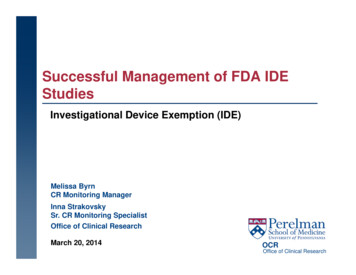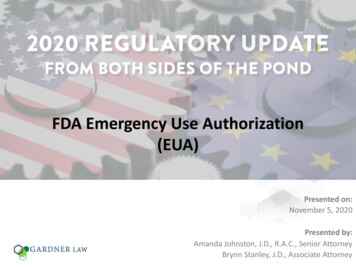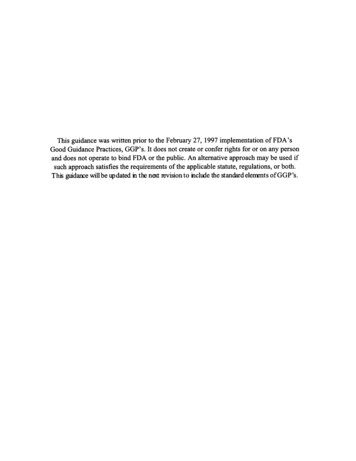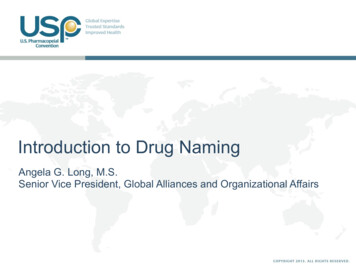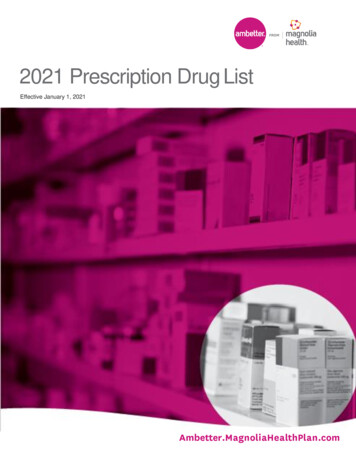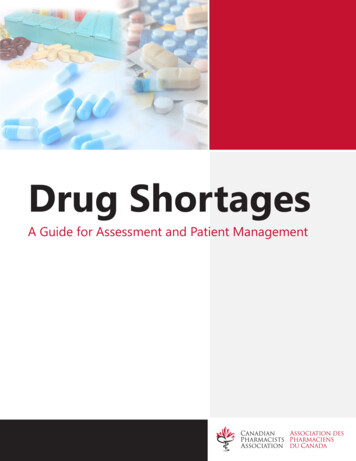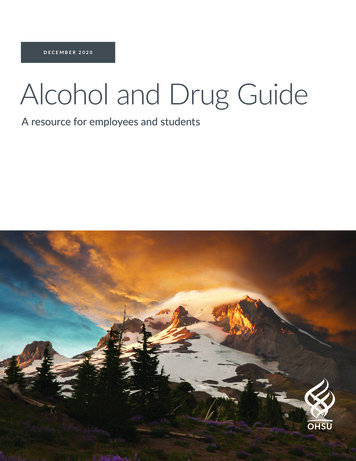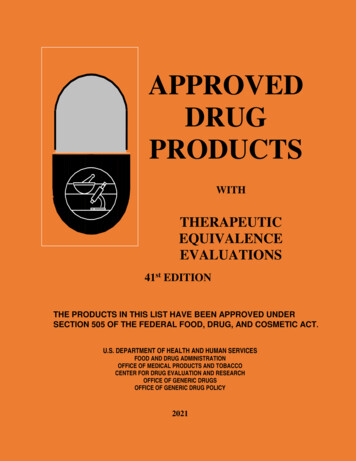
Transcription
UATIONS41st EDITIONTHE PRODUCTS IN THIS LIST HAVE BEEN APPROVED UNDERSECTION 505 OF THE FEDERAL FOOD, DRUG, AND COSMETIC ACT.U.S. DEPARTMENT OF HEALTH AND HUMAN SERVICESFOOD AND DRUG ADMINISTRATIONOFFICE OF MEDICAL PRODUCTS AND TOBACCOCENTER FOR DRUG EVALUATION AND RESEARCHOFFICE OF GENERIC DRUGSOFFICE OF GENERIC DRUG POLICY2021
APPROVED DRUG PRODUCTSwithTHERAPEUTIC EQUIVALENCE EVALUATIONSThe products in this list have been approved under section 505 of theFederal Food, Drug, and Cosmetic Act. This volume is current throughDecember 31, 2020.41st EDITIONU.S. DEPARTMENT OF HEALTH AND HUMAN SERVICESFOOD AND DRUG ADMINISTRATIONOFFICE OF MEDICAL PRODUCTS AND TOBACCOCENTER FOR DRUG EVALUATION AND RESEARCHOFFICE OF GENERIC DRUGSOFFICE OF GENERIC DRUG POLICY2021
FOOD AND DRUG ADMINISTRATIONCENTER FOR DRUG EVALUATION AND RESEARCHAPPROVED DRUG PRODUCTSWithTherapeutic Equivalence EvaluationsCONTENTSPAGEPREFACE TO FORTY FIRST EDITION . . . . iv1.0 INTRODUCTION . vi1.1Content and Exclusion . vi1.2Therapeutic Equivalence-Related Terms .vii1.3Further Guidance on Bioequivalence . ix1.4Reference Listed Drug and Reference Standard. x1.5General Policies and Legal Status . xi1.6Practitioner/User Responsibilities . xi1.7Therapeutic Equivalence Evaluations Codes .xii1.8Description of Certain Special Situations . xx1.9Therapeutic Equivalence Code Change for a Drug Entity . xxiii1.10 Change of the Therapeutic Equivalence Evaluation for a Single Product .xxiv1.11 Discontinued Section .xxiv1.12 Changes to the Orange Book.xxiv1.13 Availability of the Edition .xxv2.02.12.22.3HOW TO USE THE DRUG PRODUCTS LISTS .2-1Key Sections for Using the Drug Product Lists . . . .2-1Drug Product Illustration . . . . .2-3Therapeutic Equivalence Evaluations Illustration . . . . 2-4DRUG PRODUCT LISTSPrescription Drug Product List . . .3-1OTC Drug Product List . . 4-1Drug Products with Approval under Section 505 of the FD&C Act Administeredby the Center for Biologics Evaluation and Research List . . . .5-1Discontinued Drug Product List . . . .6-1Orphan Products Designations and Approvals List . . . .7-1Drug Products Which Must Demonstrate in vivo BioavailabilityOnly if Product Fails to Achieve Adequate Dissolution . .8-1APPENDICESA. Product Name Index . . . . A-1B. Product Name Index Listed by Applicant . . .B-1C. Uniform Terms . . . .C-1PATENT AND EXCLUSIVITY INFORMATION ADDENDUM . . .AD1A. Patent and Exclusivity Lists . . . . ADA1B. Patent and Exclusivity Terms . . . . ADB1
FOOD AND DRUG ADMINISTRATIONCENTER FOR DRUG EVALUATION AND RESEARCHAPPROVED DRUG PRODUCTSWithTherapeutic Equivalence EvaluationsPREFACE TO FORTY FIRST EDITIONThe publication, Approved Drug Products With Therapeutic EquivalenceEvaluations (the List, commonly known as the Orange Book), identifies drugproducts approved on the basis of safety and effectiveness by the Food andDrug Administration (FDA) under the Federal Food, Drug, and Cosmetic Act (theFD&C Act). The main criterion for the inclusion of any product is that theproduct is the subject of an application with an approval that has not beenwithdrawn for safety or efficacy reasons. Inclusion of products in theOrange Book is independent of any current regulatory action being takenadministratively or judicially against a drug product. In addition, theOrange Book contains therapeutic equivalence evaluations for approvedmultisource prescription drug products. These evaluations have been preparedto serve as public information and advice to state health agencies,prescribers, and pharmacists to promote public education in the area of drugproduct selection and to foster containment of health care costs.Therapeutic equivalence evaluations in this publication are not official FDAactions affecting the legal status of products under the FD&C Act.Background of the Publication. To contain drug costs, virtually everystate has adopted laws and/or regulations that encourage the substitution ofdrug products. These state laws generally require either that substitutionbe limited to drugs on a specific list (the positive formulary approach) orthat it be permitted for all drugs except those prohibited by a particularlist (the negative formulary approach). Because of the number of requests inthe late 1970s for FDA assistance in preparing both positive and negativeformularies, it became apparent that FDA could not serve the needs of eachstate on an individual basis. The Agency also recognized that providing asingle list based on common criteria would be preferable to evaluating drugproducts on the basis of differing definitions and criteria in various statelaws. As a result, on May 31, 1978, the Commissioner of the Food and DrugAdministration sent a letter to officials of each state announcing FDA'sintent to provide a list of all prescription drug products that are approvedby FDA for safety and effectiveness, along with therapeutic equivalencedeterminations for multisource prescription products.The Orange Book was distributed as a proposal in January 1979. Itincluded only currently marketed prescription drug products approved by FDAthrough new drug applications (NDAs) and abbreviated new drug applications(ANDAs)under the provisions of Section 505 of the FD&C Act and FDAregulations at that time.The therapeutic equivalence evaluations in the Orange Book reflect FDA'sapplication of specific criteria to the multisource prescription drugproducts listed in the Orange Book and approved under Section 505 of the FD&CAct. These evaluations are presented in the form of code letters thatindicate the basis for the evaluation made. An explanation of the codesappears in the Introduction.iv
A complete discussion of the background and basis of FDA's therapeuticequivalence evaluation policy was published in the Federal Register onJanuary 12, 1979 (44 FR 2932). The final rule, which includes FDA'sresponses to the public comments on the proposal, was published in theFederal Register on October 31, 1980 (45 FR 72582). The first publication ofthe Orange Book in October 1980, concurrent with finalization of the rule,incorporated appropriate corrections and additions. Each subsequent editionhas included new approvals and made appropriate changes in data.On September 24, 1984, the President signed into law the Drug PriceCompetition and Patent Term Restoration Act of 1984 (Hatch-WaxmanAmendments). The Hatch-Waxman Amendments amended the FD&C Act to establish,among other things, the 505(b)(2) and 505(j) approval pathways. The HatchWaxman Amendments require that FDA, among other things, make publiclyavailable a list of approved drug products with monthly supplements. TheOrange Book and its monthly Cumulative Supplements satisfy this requirement.The Addendum to this publication identifies drugs that have qualified underthe FD&C Act for periods of exclusivity and provides patent informationconcerning the approved drug products in the Orange Book. The Addendum alsoprovides additional information that may be helpful to those submitting anNDA under section 505(b) of the FD&C Act or an abbreviated new drugapplication (ANDA) under section 505(j) of the FD&C Act to the Agency.The Agency intends to use this publication to further its objective ofobtaining input and comment on the publication itself and related Agencyprocedures. Therefore, if you have comments on how the publication can beimproved, please send them to the Central Document Room, Attn: Director,Division of Legal and Regulatory Support, Office of Generic Drug Policy,Center for Drug Evaluation and Research, Food and Drug Administration, 5901-BAmmendale Rd., Beltsville, MD 20705-1266. Comments received are publiclyavailable to the extent allowable under the Freedom of Information Act andFDA regulations.v
1.0 INTRODUCTION1.1 Content and ExclusionThe Orange Book is composed of four parts: (1) approved prescription drugproducts with therapeutic equivalence evaluations; (2) approvedover-the-counter (OTC) drug products for those drugs that may not be marketedwithout NDAs or ANDAs because they are not covered under existing OTCmonographs; (3) drug products with approval under Section 505 of the FD&C Actadministered by the Center for Biologics Evaluation and Research; and (4) acumulative list of approved products that have never been marketed, are forexportation, are for military use, have been discontinued from marketing andwe have not determined that they were withdrawn from sale for safety oreffectiveness reasons, or have had their approvals withdrawn for other thansafety or efficacy reasons subsequent to being discontinued from marketing. 1This publication also includes indices of prescription and OTC drug productsby proprietary name (brand name or trade name) or, if no proprietary nameexists, established name of the active ingredient and by applicant name,which have been abbreviated for this publication. Established names foractive ingredients generally conform to compendial names or United StatesAdopted Names (USAN) as described in 21 CFR 299.4(e). A list of uniformterms is provided in Appendix C.The Addendum contains patent and exclusivity information for thePrescription, OTC, Discontinued Drug Product Lists, and for the Drug Productswith Approval under Section 505 of the FD&C Act Administered by the Centerfor Biologics Evaluation and Research. The publication may includeadditional information that the Agency deems appropriate to disseminate.Prior to the 6th Edition, the publication had excluded OTC drug productsand drug products with approval under Section 505 of the FD&C Actadministered by the Center for Biologics Evaluation and Research. The HatchWaxman Amendments required the Agency to begin publishing an up-to-date listof all marketed drug products, OTC as well as prescription, that have beenapproved for safety and efficacy and for which new drug applications arerequired.Under the FD&C Act, some drug products are given tentative approvals. TheAgency will not include drug products with tentative approvals in the OrangeBook because a drug product that is granted tentative approval is not anapproved drug product. Tentative approval lists by month are available onFDA’s website Drugs@FDA. When the tentative approval becomes a finalapproval through a subsequent action letter to the applicant, the Agency willlist the drug product and the date of approval in the appropriate approveddrug product list. In addition, we note that Section 505(x) of the FD&C Actaffects the date of approval for certain drug products subject to schedulingunder the Controlled Substances Act. The Agency will list the drug product inthe Orange Book and the date of approval as determined under Section 505(x).The Orange Book identifies the application holder of a drug product anddoes not identify distributors or repackagers.Generally, newly approved products are added to the Active Section of the Orange Book (i.e.,the Prescription Drug Product List or the Over-the-Counter Drug Product List), depending on thedispensing requirements (prescription or OTC) or approval authority, unless the Orange Book staffis otherwise notified before publication. See Section 1.12.1vi
1.2 Therapeutic Equivalence-Related TermsPharmaceutical Equivalents. Pharmaceutical equivalents are drug productsin identical dosage forms and route(s) of administration that containidentical amounts of the identical active drug ingredient, i.e., the samesalt or ester of the same therapeutic moiety, or, in the case of modifiedrelease dosage forms that require a reservoir or overage or such forms asprefilled syringes where the residual volume may vary, that deliver identicalamounts of the active drug ingredient over the identical dosing period; donot necessarily contain the same inactive ingredients; and meet the identicalcompendial or other applicable standard of identity, strength, quality, andpurity, including potency and, where applicable, content uniformity,disintegration times, and/or dissolution rates. 2 They may differ incharacteristics such as shape, scoring configuration, release mechanisms,packaging, excipients (including colors, flavors, preservatives), expirationdate/time, and, within certain limits, labeling.Pharmaceutical Alternatives. Pharmaceutical alternatives are drugproducts that contain the identical therapeutic moiety, or its precursor, butnot necessarily in the same amount or dosage form, or the same salt or ester(e.g., tetracycline hydrochloride, 250mg capsules vs. tetracycline phosphatecomplex, 250mg capsules; quinidine sulfate, 200mg tablets vs. quinidinesulfate, 200mg capsules). 3 Each such drug product individually meets eitherthe identical or its own respective compendial or other applicable standardof identity, strength, quality, and purity, including potency and, whereapplicable, content uniformity, disintegration times, and/or dissolutionrates. 4 Different dosage forms and strengths within a product line by asingle manufacturer are pharmaceutical alternatives, as are extended-releaseproducts when compared with immediate-release or standard-releaseformulations of the same active ingredient.Therapeutic Equivalents. Approved drug products are considered to betherapeutic equivalents if they are pharmaceutical equivalents for whichbioequivalence has been demonstrated, and they can be expected to have thesame clinical effect and safety profile when administered to patients underthe conditions specified in the labeling. 5FDA classifies as therapeutically equivalent those drug products that meetthe following general criteria: (1) they are approved as safe and effective;(2) they are pharmaceutical equivalents in that they (a) contain identicalamounts of the identical active drug ingredient in the identical dosage formand route of administration, and (b) meet compendial or other applicablestandards of strength, quality, purity, and identity; (3) they arebioequivalent in that (a) they do not present a known or potentialbioequivalence problem, and they meet an acceptable in vitro standard, or (b)if they do present such a known or potential problem, they are shown to meetan appropriate bioequivalence standard; (4) they are adequately labeled; and(5) they are manufactured in compliance with Current Good ManufacturingPractice regulations. The concept of therapeutic equivalence applies only todrug products containing the identical active ingredient(s) and does notencompass a comparison of different therapeutic agents used for the samecondition (e.g., meperidine hydrochloride vs. morphine sulfate for thetreatment of pain). Any drug product in the Orange Book repackaged and/ordistributed by other than the applicant is considered to be therapeuticallyequivalent to the applicant’s drug product even if the applicant’s drug234521 CFRSee 2121 CFR21 CFR314.3(b).CFR 314.3(b).314.3(b).314.3(b).vii
product is single source or coded as non-equivalent (e.g., BN). Distributorsor repackagers of an applicant’s drug product are not identified in theOrange Book.FDA considers drug products to be therapeutically equivalent if they meetthe criteria outlined above, even though they may differ in certain othercharacteristics such as shape, scoring configuration, release mechanisms,packaging, excipients (including colors, flavors, preservatives), expirationdate/time, certain aspects of labeling (e.g., the presence of specificpharmacokinetic information), and storage conditions. When such differencesare important in the care of a particular patient, it may be appropriate forthe prescribing physician to require that a specific product be dispensed asa medical necessity. With this limitation, however, FDA believes thatproducts classified as therapeutically equivalent can be substituted with thefull expectation that the substituted product can be expected to have thesame clinical effect and safety profile as the prescribed product whenadministered to patients under the conditions specified in the labeling.Strength. Strength refers to the amount of drug substance contained in,delivered, or deliverable from a drug product, which includes: (1)(a) thetotal quantity of drug substance in mass or units of activity in a dosageunit or container closure (e.g., weight/unit dose, weight/volume orweight/weight in a container closure, or units/volume or units/weight in acontainer closure); and/or, as applicable, (b) the concentration of the drugsubstance in mass or units of activity per unit volume or mass (e.g., weight/weight, weight/volume, or units/volume); or (2) such other criteria theAgency establishes for determining the amount of drug substance contained in,delivered, or deliverable from a drug product if the weights and measuresdescribed in clause (1)(a) do not apply (e.g., certain drug-devicecombination products for which the amount of drug substance is emitted peruse or unit time). 6 Note that if the criteria the Agency establishes fordetermining and expressing the amount of drug substance in a product evolvesover time, the Agency generally does not intend to revise the expressions ofstrength for drug products already included in the Orange Book, but ratherintends to apply the criteria prospectively to drug products added to theOrange Book.Although the strength of drug products in the Orange Book is generallyexpressed in terms of the amount of drug substance (active ingredient) in thedrug product, it is sometimes expressed in terms of the amount of the activemoiety. For example, certain drug products included in the Orange Bookinclude a designation of “EQ” next to their expression of strength. This“EQ” designation generally is used in connection with salt drug products toindicate that the strength of such drug product is being expressed in termsof the equivalent strength of the active moiety (e.g., “EQ 200MG BASE”),rather than in terms of the strength of the active ingredient.Bioavailability. Bioavailability is the rate and extent to which theactive ingredient or active moiety is absorbed from a drug product andbecomes available at the site of drug action. For drug products that are notintended to be absorbed into the bloodstream, bioavailability may be assessedby scientifically valid measurements intended to reflect the rate and extentto which the active ingredient or active moiety becomes available at the siteof drug action. 76721 CFR 314.3(b).21 CFR 314.3(b).viii
Bioequivalence. Bioequivalence is the absence of a significant differencein the rate and extent to which the active ingredient or active moiety inpharmaceutical equivalents or pharmaceutical alternatives becomes availableat the site of drug action when administered at the same molar dose undersimilar conditions in an appropriately designed study. 8 Section 505(j)(8)(B)of the FD&C Act describes certain conditions under which a test drug andreference listed drug (see Section 1.4) shall be considered bioequivalent:(i) the rate and extent of absorption of the [test] drug do not show asignificant difference from the rate and extent of absorption ofthe [reference] listed drug when administered at the same molardose of the therapeutic ingredient under similar experimentalconditions in either a single dose or multiple doses; or(ii) the extent of absorption of the [test] drug does not show asignificant difference from the extent of absorption of the[reference] listed drug when administered at the same molar doseof the therapeutic ingredient under similar experimentalconditions in either a single dose or multiple doses and thedifference from the [reference] listed drug in the rate ofabsorption of the drug is intentional, is reflected in itsproposed labeling, is not essential to the attainment ofeffective body drug concentrations on chronic use, and isconsidered medically insignificant for the drug.Where these above methods are not applicable (e.g., for drug products thatare not intended to be absorbed into the bloodstream), other scientificallyvalid in vivo or in vitro test methods to demonstrate bioequivalence may beappropriate.For example, bioequivalence may sometimes be demonstrated using an invitro bioequivalence standard, especially when such an in vitro test has beencorrelated with human in vivo bioavailability data. In other situations,bioequivalence may sometimes be demonstrated through comparative clinicaltrials or pharmacodynamic studies. 91.3 Further Guidance on BioequivalenceFDA’s regulations and guidance documents provide additional informationregarding bioequivalence and bioavailability, including methodologies andstatistical criteria used to establish the bioequivalence of drug products. 1021 CFR 314.3(b).21 CFR 320.24.10We note that prior to the 36th edition of the Orange Book, the Preface to the Orange Bookincluded a section entitled “Statistical Criteria for Bioequivalence.” Please see FDA’sregulations and guidance d/////ocuments for additional information regarding bioequivalence andbioavailability. See generally 21 CFR part 320. See FDA Drugs guidance Web page gulatory-information/guidances-drugs and FDADrugs guidance (Product-Specific Guidances for Generic Drug Development) Web page t-specific-guidances-generic-drug-development.89ix
1.4 Reference Listed Drug and Reference StandardA reference listed drug is the listed drug 11 identified by FDA as the drugproduct upon which an applicant relies in seeking approval of its ANDA. 12Generally, a reference listed drug is a drug product approved in a new drugapplication under Section 505(c) of the FD&C Act based on full reports ofinvestigations of safety and effectiveness. For an ANDA based on an approvedsuitability petition (a petitioned ANDA), the reference listed drug generallyis the listed drug referenced in the approved suitability petition. 13A reference standard is the drug product selected by FDA that an applicantseeking approval of an ANDA must use in conducting an in vivo bioequivalencestudy required for approval. 14 FDA generally selects a single referencestandard that ANDA applicants must use in in vivo bioequivalence testing.Ordinarily, FDA will select the reference listed drug as the referencestandard. However, in some instances, the reference listed drug and thereference standard may be different. For example, where the reference listeddrug has been withdrawn from sale FDA may select an ANDA as the referencestandard.FDA identifies reference listed drugs in the Prescription Drug Product,OTC Drug Product, and Discontinued Drug Product Lists. Listed drugsidentified as reference listed drugs represent drug products upon which anapplicant can rely in seeking approval of an ANDA. FDA intends to updateperiodically the reference listed drugs identified in the Prescription DrugProduct, OTC Drug Product, and Discontinued Drug Product Lists, asappropriate.In some instances when FDA has not designated a listed drug as a referencelisted drug, such listed drug may be shielded from generic competition. IfFDA has not designated a reference listed drug for a drug product theapplicant intends to duplicate, the potential applicant may submit acontrolled correspondence to the Office of Generic Drugs to ask FDA todesignate a reference listed drug for that drug product. Section 1.7,Therapeutic Equivalence Evaluations Codes (products meeting necessarybioequivalence requirements) explains the character coding system (e.g., AB,AB1, AB2, AB3.) for multisource drug products listed under the same headingwith two or more reference listed drugs.FDA also identifies reference standards in the Prescription Drug Productand OTC Drug Product Lists. Listed drugs identified as reference standardsrepresent FDA’s best judgment at this time as to the appropriate comparatorfor purposes of conducting any in vivo bioequivalence studies required forapproval.A potential applicant should consult Agency guidance related toreferencing approved drug products in ANDA submissions for information onsubmitting a request for selection of a reference standard. FDA may, on itsown initiative, select a new reference standard when doing so will help toensure that applications for generic drugs may be submitted and evaluated,11A “listed drug” is a new drug product that has been approved under section 505(c) of the FD&CAct for safety and effectiveness or under section 505(j) of the FD&C Act, which has not beenwithdrawn or suspended under section 505(e)(1) through (5) or section 505(j)(6) of the FD&C Act,and which has not been withdrawn from sale for what FDA has determined are reasons of safety oreffectiveness. Listed drug status is evidenced by the drug product's identification in thecurrent edition of FDA’s “Approved Drug Products With Therapeutic Equivalence Evaluations” (thelist) as an approved drug. A drug product is deemed to be a listed drug on the date of approvalfor the NDA or ANDA for that drug product (21 CFR 314.3(b)).12 21 CFR 314.3(b).13 21 CFR 314.94(a)(3)(i).14 21 CFR 314.3(b).x
e.g., in the event that the listed drug currently selected as the referencestandard has been withdrawn from saleIf an applicant has a question related to the appropriate referencestandard, it is recommended that an applicant planning to conduct an in vivobioequivalence study submit a controlled correspondence to the Office ofGeneric Drugs.1.5 General Policies and Legal StatusThe Orange Book contains public information and advice. It does notmandate the drug products that are purchased, prescribed, dispensed, orsubstituted for one another, nor does it, conversely, mandate the productsthat should be avoided. To the extent that the Orange Book sets forth FDA'sevaluations of the therapeutic equivalence of drug products that have beenapproved, it contains FDA's advice to the public, to practitioners, and tothe states regarding drug product selection. These evaluations do notconstitute determinations that any product is in violation of the FD&C Act orthat any product is preferable to any other. Therapeutic equivalenceevaluations are a scientific judgment based upon evidence, while genericsubstitution may involve social and economic policy administered by thestates, e.g., reducing the cost of drugs to consumers. To the extent thatthe Orange Book identifies drug products approved under Section 505 of theFD&C Act, it sets forth information that the Agency is required to publishand that the public is entitled to under the Freedom of Information Act.Exclusion of a drug product from the Orange Book does not necessarily meanthat the drug product is in violation of Section 505 of the FD&C Act, thatsuch a product is not safe or effective, or that such a product is nottherapeutically equivalent to other drug products. Rather, the exclusion maybe based on the fact that FDA has not evaluated the safety, effectiveness,and quality of the drug product.1.6Practitioner/User ResponsibilitiesProfessional care and judgment should be exercised in using the OrangeBook. Evaluations of therapeutic equivalence for prescription drugs are basedon scientific and medical evaluations by FDA. Products evaluated astherapeutically equivalent can be expected, in the judgment of FDA, to havethe same clinical effect and safety profile when administered to patientsunder the conditions specified in the labeling. However, these products maydiffer in other characteristics that are not required by statute orregulation to be the same, such as shape, scoring configuration, releasemechanisms, packaging, excipients (including colors, flavors, preservatives),expiration date/time, and, in some instances, labeling. If products withsuch differences are substituted for each other, there is a potential forpatient confusion, e.g., due to differences in color or shape of tablets,inability to provide a given dose using a partial tablet if the properscoring configuration is not available, or decreased patient acceptance ofcertain products because of flavor. There may also be patient-specificallergic reactions in rare cases due to a coloring or a preservativeingredient.FDA evaluation of therapeutic equivalence in no way relieves practitionersof their professional responsibilities in prescribing and dispensing suchproducts with due care and with appropriate information to individualpatients. In those circumstances where the characteristics of a specificproduct, other than its active ingredient, are important in the therapy of aparticular patient, the practitioner's prescribing of that product may beappropriate. Pharmacists
Approved Drug Products With Therapeutic Equivalence Evaluations (the List, commonly known as the Orange Book), identifies drug products approved on the basis of safety and effectiveness by the Food and Drug Administration (FDA) under the Federal Food, Drug, and Cosmetic Act (the FD&C Act).
